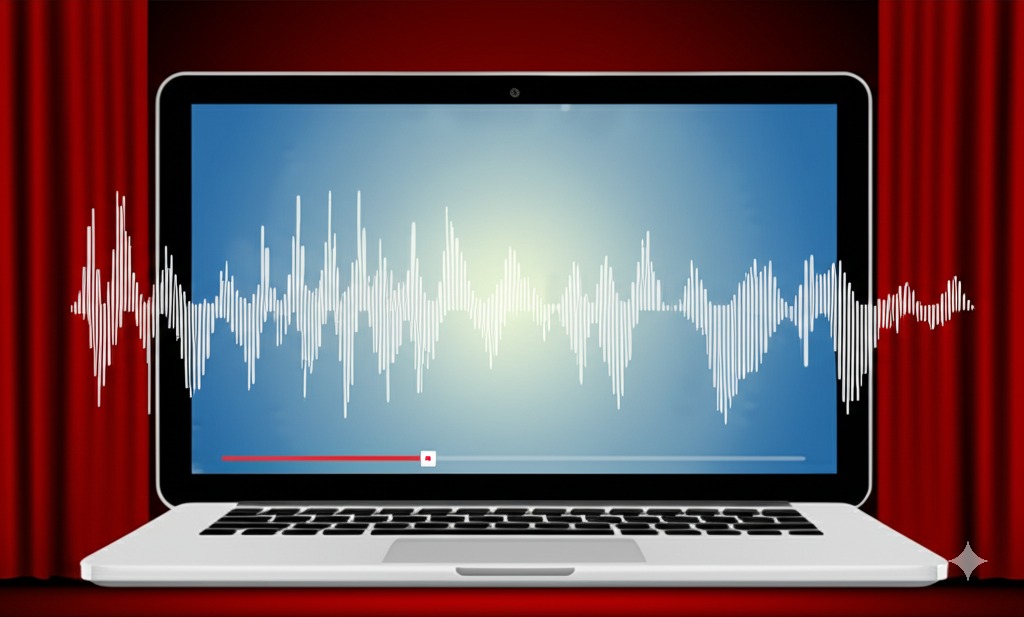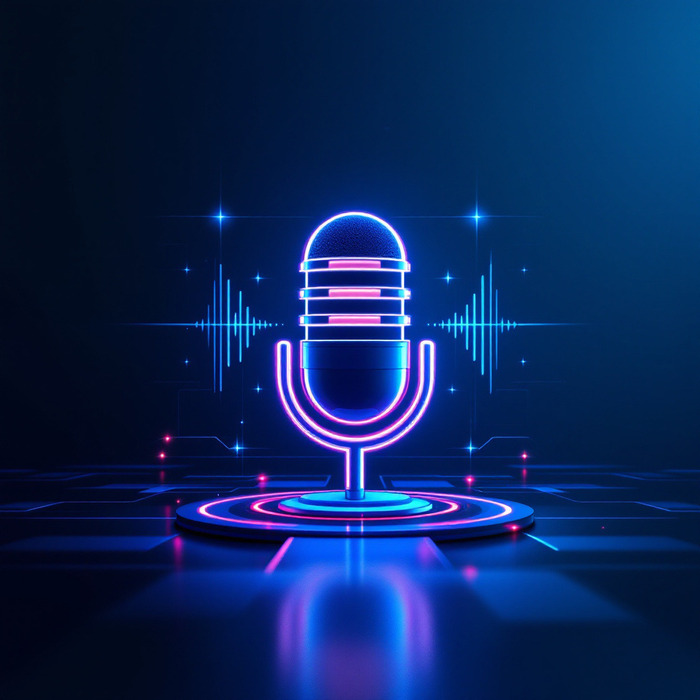
AI text to speech for stand-up comedy transforms how comedians practice. When comedians write jokes, they need to hear them spoken aloud to know if they work.
This technology speaks their material out loud, letting them catch problems with timing, word choice, and flow before they ever step on stage. For comedians tired of awkward mirror practice or bombing at open mics with untested material, these tools offer a better way to refine their craft.
Stand-up comedy fails or succeeds based on delivery. A great joke with poor timing bombs, while even simple material can kill with perfect delivery. The problem? Most comedians have no good way to practice delivery until they’re already on stage facing a real audience.
AI text to speech for stand-up comedy fills this gap in the creative process. These tools read your jokes aloud in natural-sounding voices, letting you hear problems that aren’t obvious when you’re just reading silently. Awkward phrases, unclear setups, and weak punchlines become immediately apparent when spoken out loud.
The best part? You can experiment freely without the pressure of a live audience. Test different pauses, emphasis, or even completely different approaches to the same joke. This kind of rapid experimentation would be impossible at open mics, where you get one shot before moving on.

How AI is Changing Comedy Writing and Practice
Traditional comedy practice has always been a bit awkward. You stand in front of a mirror, talk to yourself, or record videos that you cringe while watching. Getting real feedback usually means going to open mics and bombing in front of strangers.
AI for stand-up comedy creates a middle ground where you can practice more effectively before hitting the stage. Here’s what makes it so useful:
- You can hear your jokes spoken aloud without recording yourself
- You can try different delivery styles with the click of a button
- You get objective feedback on timing and pacing
- You can practice as much as you want without annoying your roommates
- You don’t have to face the awkwardness of bombing while still figuring out your material
For new comedians, this means developing confidence before the first open mic. For experienced performers, it provides a way to test and refine material systematically rather than just going by gut feeling.
Some comedians were skeptical at first, but many now use text to speech for comedians as a regular part of their writing process. They’ve found that hearing their jokes spoken aloud helps identify problems and opportunities they might miss when just reading silently.
Breaking Down Successful Comedy with AI Tools
One of the coolest uses of AI text to speech for stand-up comedy is analyzing why successful bits work. Great comedians make it look effortless, but there’s actually a science to good comedy timing.
Here’s a practical approach to learning from the best:
- Transcribe a successful comedian’s bit that you admire
- Input it into an AI voice system
- Analyze the timing elements – where they pause, which words they emphasize
- Try the same bit with different timing to see how it changes
- Apply those insights to your own material
For example, you might notice that a comedian pauses for exactly 1.5 seconds before a punchline, or that they speak 20% faster during setup and slower during important details. These aren’t things they consciously planned – they’ve developed the timing through experience. But you can accelerate your learning by identifying these patterns.
Some comedy timing practice tools even include features specifically for this type of analysis, showing you visual representations of pace, emphasis, and timing.
Setting Up Your AI Comedy Practice Space
You don’t need fancy equipment to use AI text to speech for stand-up comedy, but having the right setup makes a big difference.
Here’s a simple but effective practice environment:
- A quiet room where you can focus without distractions
- A computer or tablet with your AI voice software
- A way to record your practice sessions (most computers have built-in microphones)
- Headphones for focused listening
- A microphone similar to what you’ll use on stage (optional but helpful)
The key is creating a consistent space where you can practice regularly. Some comedians dedicate 30 minutes daily to AI practice, listening to their material, making adjustments, and trying different approaches.
Setting up a regular practice schedule is important. The comedians who benefit most from these tools are the ones who use them consistently, not just when inspiration strikes.
Many AI text to speech solutions can work on basic laptops without any special equipment, making this accessible even for beginners on a tight budget.
Choosing the Right AI Voices for Comedy
Not all AI voices work well for comedy practice. Some sound too robotic or lack the expressiveness needed for jokes. The best AI voice comedy rehearsal tools offer voices with these qualities:
- Natural-sounding speech patterns
- Ability to emphasize specific words
- Control over pausing and pacing
- Different emotion settings
- Various character voices for different styles
Many comedians create “voice profiles” that match their own natural speaking style or the style they aspire to develop. Others use different voices to represent different character perspectives in their bits.
For testing demographic reactions, you can select voices that represent your target audience. For example, if you perform at college campuses, using younger-sounding voices might help you gauge how your material might land with that crowd.
Some comedians even use AI voice cloning to create a synthetic version of their own voice for practice. This can be especially helpful for hearing how your personal delivery style works with different material.

Mastering Timing and Pacing with AI Tools
Timing is everything in comedy, and it’s one of the hardest skills to develop. AI text to speech for stand-up comedy gives you precise control over this crucial element.
Here are specific techniques to improve your timing:
- The Pause Test: Try different pause lengths before punchlines (1 second, 2 seconds, etc.) to find the sweet spot
- Emphasized Word Variations: Change which words you emphasize to see how it affects the joke
- Speed Mapping: Create a “speed map” of your routine, showing where you speed up and slow down
- Comparison Testing: Try telling the same joke with completely different timing approaches and compare the results
One comedian described this process as “having a comedy coach available 24/7.” The ability to make tiny adjustments and immediately hear the results accelerates the learning process dramatically.
For developing comedians, these joke delivery improvement tools provide objective feedback that’s hard to get elsewhere. You can literally see and hear what works better.
Experimenting with Different Delivery Styles
Everyone starts comedy by imitating their influences. Finding your authentic voice takes time, but AI for stand-up comedy can help you experiment safely.
Try these experiments with AI voice tools:
- Take one of your jokes and deliver it in the style of 3-5 different comedians you admire
- Try completely different emotional approaches to the same bit (excited, deadpan, confused)
- Test different persona elements (confident, self-deprecating, sarcastic)
- Adjust the pacing from very slow to very fast
The goal isn’t to copy someone else’s style but to expand your range and find what feels authentically “you” while still connecting with audiences.
Many successful comedians say they developed their unique voice by trying many approaches and gradually keeping what worked best for them. AI voice comedy rehearsal lets you do this experimentation efficiently.
Creating a Virtual Audience for Feedback
One of the biggest challenges in practicing comedy alone is the lack of audience feedback. Some advanced AI text to speech for stand-up comedy platforms now include audience simulation features.
These tools can:
- Generate appropriate laughter at punchlines
- Create different types of audience responses (chuckles, big laughs, groans)
- Simulate different venue environments (intimate club, large theater)
- Provide variations in audience energy levels
This might sound gimmicky, but many comedians find it genuinely helpful for mentally preparing for real performances. It’s obviously not the same as a real crowd, but it helps bridge the gap between practicing alone and being on stage.
Some comedians use these simulations to practice handling tough situations like hecklers or quiet crowds. This builds resilience and confidence for when those scenarios happen in real life.
For dealing with performance anxiety, emotional AI voice technologies can create increasingly challenging scenarios, helping you gradually build comfort with performing.
Transitioning from AI Practice to Live Performance
AI practice is useful, but comedy ultimately happens in front of real people. Here’s how to effectively bridge that gap:
- Record yourself performing the material after AI practice
- Start with small, friendly audiences for new material
- Pay attention to where real audience reactions differ from your AI predictions
- Be ready to adjust timing on the fly based on real crowd energy
- Use AI between shows to refine material based on live feedback
Many comedians use a cycle: write material → practice with AI → try at open mics → revise with AI based on real feedback → perform improved version.
The key is recognizing that virtual audience for comedians tools are just that – tools. They complement live performance experience rather than replacing it.
Several comedians report that after using AI practice tools, they feel more prepared and confident at actual shows. The material feels “broken in” even before its first public performance.

Technical Tips for Getting the Most from AI Voice Tools
To get the best results from comedy script practice with AI, try these technical approaches:
- Format your script carefully: Most AI systems respond to punctuation. Use commas for short pauses, periods for longer ones, and exclamation points for emphasis.
- Add performance notes: Many systems let you add notes like [pause], [quickly], or [excited] to control delivery.
- Break lines strategically: How you break up text affects how the AI reads it. Separate setup and punchline into different lines.
- Test small sections first: Don’t input your entire set at once. Work with individual jokes until they sound right.
- Save different versions: Keep alternative versions of jokes with different timing and emphasis to compare them.
The evolution of text to speech technology has made these tools much more user-friendly, but these formatting tricks can take your practice to another level.
Real Comedians Using AI Voice Technology
Several professional comedians are already incorporating AI text to speech for stand-up comedy into their workflow:
A professional comedian reported cutting his material development time in half using AI-driven TTS technology for rapid joke testing. He can now test 20-30 variations of a joke in the time it used to take to try 5-6 approaches.
Other examples include comedy writers testing demographic reactions with varied AI voices and podcast comedy teams using AI for timing coordination. Most report measurable improvements in both efficiency and final performance quality.
What’s particularly interesting is how comedians are combining AI voice comedy rehearsal with other creative tools. Some use AI voice tools alongside traditional writing methods, while others have developed entirely new workflows centered around hearing rather than reading their material.
Overcoming Stage Fright Through AI Practice
For many comedians, especially beginners, stage fright is a major obstacle. AI text to speech for stand-up comedy can help reduce this anxiety through systematic practice.
The psychology is similar to how pilots use flight simulators – the more you practice in a simulated environment, the more comfortable you feel in the real situation.
Specific techniques include:
- Practicing with simulated audience noises at increasing volumes
- Recording your material with AI voices and listening to it in the venue before performing
- Using progressive exposure by practicing with small simulated audiences and gradually increasing the size
- Creating mental “anchors” by practicing the same opening lines repeatedly until they feel automatic
Many comedians report that after extensive AI practice, their material feels “worn in” like a comfortable pair of shoes. The familiarity reduces anxiety and lets them focus on connecting with the audience rather than remembering their next line.
These digital comedy script testing approaches don’t eliminate nerves completely (nor should they – some nervous energy is good for performance), but they can reduce anxiety to manageable levels.
Different Applications for Various Comedy Formats
AI text to speech for stand-up comedy isn’t just for traditional stand-up. Different comedy formats can benefit in unique ways:
For Stand-Up Comics
- Test the flow of your set with transitions between bits
- Try different orders for your jokes to find the best arrangement
- Practice timing and pacing for specific venues
For Improv Performers
- Generate random suggestions to practice quick reactions
- Work on character voices and consistent personalities
- Practice maintaining different emotional states throughout scenes
For Comedy Writers
- Hear how your jokes sound when performed by different voice types
- Test material across different demographic voices
- Identify and fix awkward phrasing that looks fine on paper but sounds clunky when spoken
For Podcast Comedians
- Practice conversational timing with multiple AI voices
- Test different energy levels for the same content
- Develop consistent character voices for recurring segments
Each format has specific needs, but the core benefit remains: hearing your comedy out loud provides insights you can’t get from reading silently.

Frequently Asked Questions
Can AI really help improve my comedic timing?
Yes, but not by itself. AI text to speech for stand-up comedy helps you hear your jokes performed with different timing options, but you still need to develop the judgment about what works best. It’s a tool for practice and experimentation, not a replacement for developing your comedy instincts.
How realistic do AI voices need to be for effective practice?
They don’t need to be perfect. Even voices that sound somewhat artificial can help you test timing, word choice, and joke structure. That said, more natural-sounding voices make the practice experience more realistic and enjoyable. Focus more on voices with good timing control than perfect naturalness.
What are the best AI platforms specifically for comedy practice?
While there aren’t many tools designed exclusively for comedy, several general AI voice comedy rehearsal platforms work well. Look for ones that offer good control over timing, emphasis, and emotional tone. Some comedians report good results with ElevenLabs, PlayHT, and Descript’s Overdub feature.
Can AI help determine if a joke will work before performing it?
It can help identify technical issues like awkward phrasing or timing problems, but it can’t predict how a real audience will react to your content. Comedy is contextual and depends on the relationship between performer and audience. AI tools help with delivery mechanics, not guaranteeing laughs.
How do I transition from AI practice to live performance?
Start with low-pressure environments like friendly open mics. Expect to make adjustments based on real audience feedback. The transition will be smoother if you’ve used AI practice as a supplement to, not a replacement for, traditional comedy development methods.
Conclusion
AI text to speech for stand-up comedy offers a powerful new way to practice and refine your material. It’s not magic and won’t write your jokes for you, but it provides tools that previous generations of comedians could only dream about.
The comedians who benefit most from this technology use it as part of a broader approach to developing their craft. They combine AI practice with writing, live performance, and careful analysis of what works and what doesn’t.
As AI voice technology continues to improve, we can expect even more sophisticated tools designed specifically for comedy practice. But even the current generation of tools offers tremendous value for comedians willing to incorporate them into their process.
Whether you’re just starting out or have been performing for years, AI for stand-up comedy can help you practice more effectively, experiment more efficiently, and ultimately bring better-crafted material to your audiences.
Sources:
https://samegreene.medium.com/building-our-own-ai-stand-up-comedian-3c938015b1a8
https://voices.directory/pages/stand-up-comedian-ai-voice-generator

